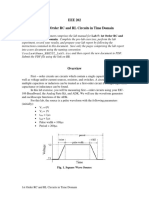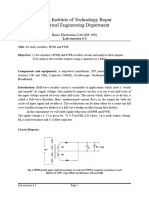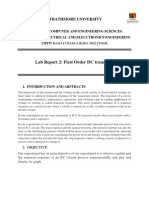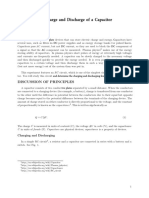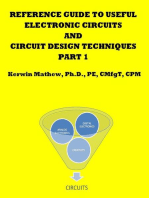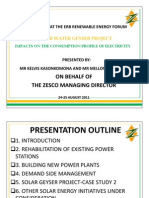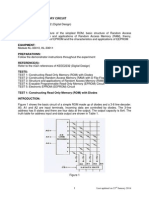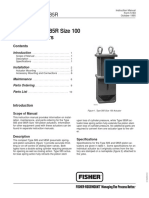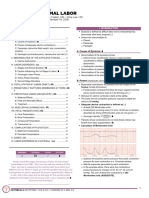C2 Pspice Experiment
C2 Pspice Experiment
Uploaded by
Gulbanu KarimovaCopyright:
Available Formats
C2 Pspice Experiment
C2 Pspice Experiment
Uploaded by
Gulbanu KarimovaOriginal Description:
Copyright
Available Formats
Share this document
Did you find this document useful?
Is this content inappropriate?
Copyright:
Available Formats
C2 Pspice Experiment
C2 Pspice Experiment
Uploaded by
Gulbanu KarimovaCopyright:
Available Formats
EXPERIMENT C2: PSPICE SIMULATION: STEP RESPONSE OF RC AND RLC CIRCUITS Associated course: KEEE1113 (Circuit Analysis 1) OBJECTIVES:
To analyse RC and RLC circuits EQUIPMENT: PC with PSpice software PRECAUTIONS: Follow the demonstrator instructions throughout the experiment REFERENCE(S): Refer to the main references of KEEE1113 (Circuit Analysis 1) TESTS: TEST 1: Pre-lab test TEST 2: RC circuit TEST 3: RLC circuit INTRODUCTION: The complete response of RC and RLC circuits to step inputs involves determination of the transient and steady state solutions of the circuit. Since the energy storage elements such as inductor and capacitor do not permit instantaneous change in energy, the transient part of the solution makes a smooth transition from one energy level to another. Thus a gradual change takes place from some initial level till the new steady state level is reached. Sudden loading of generator or a beam in a structure, sudden change in the setting of a value or failure of a hydraulic pump involves response due to step input. Step function apart from being mathematically simple to analyze, represents a rather severe type of disturbance appearing in the system. Moreover, an arbitrary function can be approximated in the form of a series of step input facilitates the finding of the response to any arbitrary input. The dynamic characteristics of a simple systems can be described by the first order(RC circuit) or second order(RLC circuit) differential equations. The complete response is then identified in two parts-complementary function(transient solution) and a particular integral(steady-state solution). It is always possible to obtain the complete response of complicated systems such as linear combination of first and second order systems. Although attention here is confined to electrical circuits, the same basic model can be used to represent a wide range of mechanical and, pneumatic or chemical systems. TEST 1: PRE-LAB 1. Series RC Circuit. For the circuit shown in Figure 1(R=470 , C=0.22uF), calculate the time constant(=RC). For R=220, recalculate the time constant. 2. Series RLC Circuit: For the circuit shown in Figure 2(L=10mH and C=1uF), the transfer function is given by
vc 1 /( LC ) = 2 VS s + ( R / L ) s + 1 /( LC )
Last updated on 9th July 2013
And, the two roots of the characteristic equation is
R 1 R = 2L LC 2L
2
2
s1, 2
a) b)
R 1 For critically damped response, is equal to be zero. Calculate R. LC 2L R 1 is less than zero. What is the range of For underdamped response, LC 2L suitable value for R? R 1 For overdamped response, is greater than zero. What is the range LC 2L of suitable value for R?
2 2
c)
TEST 2: RC CIRCUIT Objectives: 1. To observe and trace the complete response to step input 2. To determine the time constant and check with the theoretically calculated value
+ -
Figure 1. RC circuit 1. Construct the circuit as shown in Figure 1 using PSPICE ORCAD Capture Student. Set R=470 and C=0.22uF. For the voltage source, choose VPULSE from the SOURCE library. The parameters for the VPULSE are as follows: a) Low voltage, V1 = 0V e) Fall time, TF = 1ns b) High voltage, V2 = 5V f) Pulse width, PW = 1ms c) Time delay, TD = 0s g) Period, PER = 2ms d) Rise time, TR = 1ns 2. Go to PSPICE> Markers > Voltage Level. Place voltage level probes at the positive terminal of the VPULSE and capacitor. 3. Again, go to PSPICE > New Simulation Profile. On the New Simulation window, type Transient Analysis as the Name and none for the Inherit From. On the Simulation Settings window, choose Time Domain(Transient) as the Analysis Type. Set the Run Time to 2m seconds, Starting saving data after to 0 seconds and Maximum step size to 1u seconds. 4. Run the simulation. Sketch the input and output voltages as given by the simulation. Determine the rise time(10%-90%) and the time constant, from the output signal(i.e
Last updated on 9th July 2013
capacitor). Compare the time constant to the theoretically calculated value (Hint: Use Cursor). 5. Change the resistor value to 220. Repeat step (4). Comment on the changes to rise time and time constant. TEST 3: RLC circuit Objectives: 1. (a) To adjust the parameter so that a critical response of the series RLC circuit is obtained. (b) To compare the critical resistance to the theoretical value. (c) To trace the response characteristics. 2. (a) To adjust the parameters so that an under damped response of the series RLC circuit is obtained and to observe and trace the response. (b) From the trace response, to obtain the period of oscillation, time constant and peak overshoot and compare these values to the theoretically calculated values. 3. (a) To adjust the parameter values so that an over damped response of the series RLC circuit is obtained. (b) To calculate the value of the damping coefficient and to check over damping character of the circuit. (c) To trace the response characteristics.
Figure 2. RLC circuit 1. Construct the circuit as shown in Figure 2 using PSPICE ORCAD Capture Student. Set L=10mH and C=1uF. For the voltage source, choose VPULSE from the SOURCE library. The parameters for the VPULSE are as follows: a) Low voltage, V1 = 0V e) Fall time, TF = 1ns b) High voltage, V2 = 5V f) Pulse width, PW = 50ms c) Time delay, TD = 0s g) Period, PER = 100ms d) Rise time, TR = 1ns 2. Goto PSPICE> Markers > Voltage Level. Place voltage level probes at the positive terminal of the VPULSE and capacitor. 3. Again, goto PSPICE > New Simulation Profile. On the New Simulation window, type Transient Analysis as the Name and none for the Inherit From. On the Simulation Settings window, choose Time Domain(Transient) as the Analysis Type. Set the Run Time to 5m seconds, Starting saving data after to 0 seconds and Maximum step size to 1u seconds. 4. Set the resistor value, Rc for a critically damped response as calculated in the prelab. Run the simulation and sketch the result. Determine the time constant and rise time (10%-90%).
Last updated on 9th July 2013
5. For underdamped response, set the resistor value, Ru to Rc/5. Run the simulation and sketch the result. From the result, determine the following: a) Period of oscillation(compare to the theoretically calculated values) b) Time constant and Rise time (10%-90%) c) Peak overshoot 6. For overdamped response, set the resistor value Ro, to 3*Rc. Run the simulation and sketch the result. From the result, determine the time constant and rise time(10%90%). APPENDIX Step Response to RLC Circuit
Rise Time/Time Constant
Last updated on 9th July 2013
Peak Overshoot/ Period of Oscillation
END OF EXPERIMENT
Last updated on 9th July 2013
You might also like
- RC Circuits - George Ricarrson 2501987261No ratings yetRC Circuits - George Ricarrson 25019872619 pages
- Home Published Books Courses Taught Matlab, Gui Pspice Useful Links PersonalNo ratings yetHome Published Books Courses Taught Matlab, Gui Pspice Useful Links Personal8 pages
- Muhammad Raihan Sunaryo - RC Circuits - 12 Apr 2023No ratings yetMuhammad Raihan Sunaryo - RC Circuits - 12 Apr 20238 pages
- Laboratory Manual For Ac Electrical CircuitsNo ratings yetLaboratory Manual For Ac Electrical Circuits75 pages
- Eleg. 2111 Laboratory 6 "Q" Factor and Transient Response of An RLC Series CircuitNo ratings yetEleg. 2111 Laboratory 6 "Q" Factor and Transient Response of An RLC Series Circuit9 pages
- L211 Series Resonance and TimeFrequency Response of Passive Networks PDF100% (1)L211 Series Resonance and TimeFrequency Response of Passive Networks PDF25 pages
- Electrical Simulation Lab: EEE 454 IV Sem EN BranchNo ratings yetElectrical Simulation Lab: EEE 454 IV Sem EN Branch28 pages
- EEL101 Lab Manual E4 RL RC RLC Circuit ResponseNo ratings yetEEL101 Lab Manual E4 RL RC RLC Circuit Response4 pages
- 3.transient Analysis of Series RL, RC CircuitsNo ratings yet3.transient Analysis of Series RL, RC Circuits11 pages
- Práctica 3 Fundamentos de La Ingenieria ElectricaNo ratings yetPráctica 3 Fundamentos de La Ingenieria Electrica7 pages
- Digital Control Algorithm For Two-Stage DC-DC Converters: Energy ProcediaNo ratings yetDigital Control Algorithm For Two-Stage DC-DC Converters: Energy Procedia7 pages
- Lab Handout - 10 Phase Shift Measurement Iof Series RLCNo ratings yetLab Handout - 10 Phase Shift Measurement Iof Series RLC5 pages
- Ingenieria Electronica: Luis Velez Fernandez U201315423 Abel Cieza de Los Santos U820223No ratings yetIngenieria Electronica: Luis Velez Fernandez U201315423 Abel Cieza de Los Santos U82022312 pages
- Lab 01-Transient Response of A Series RC CircuitNo ratings yetLab 01-Transient Response of A Series RC Circuit4 pages
- Indian Institute of Technology Ropar Electrical Engineering DepartmentNo ratings yetIndian Institute of Technology Ropar Electrical Engineering Department3 pages
- Professor Modisette What Are Oscilloscopes?: ECE 206LNo ratings yetProfessor Modisette What Are Oscilloscopes?: ECE 206L13 pages
- 2 Experiment PSPICE RC RL and RLC SimulationNo ratings yet2 Experiment PSPICE RC RL and RLC Simulation5 pages
- ENA - Lab - Manual (Update 17-4-2019) PDFNo ratings yetENA - Lab - Manual (Update 17-4-2019) PDF76 pages
- Lab 9: Natural Response of An RC Circuit: Muhammad Ahmed Minhas FA20-BEE-2C-112No ratings yetLab 9: Natural Response of An RC Circuit: Muhammad Ahmed Minhas FA20-BEE-2C-1123 pages
- IEC - EXP - 7 - Student Manual Transient AnalysisNo ratings yetIEC - EXP - 7 - Student Manual Transient Analysis4 pages
- Charging and Discharging of A Capacitor: 5.1 CapacitorsNo ratings yetCharging and Discharging of A Capacitor: 5.1 Capacitors25 pages
- Lab Report 2: First Order DC Transients: Strathmore UniversityNo ratings yetLab Report 2: First Order DC Transients: Strathmore University7 pages
- Mohosin Ahmed Shisir - 233016010 - LR2 - EEE 1204 - Electric Circuit II LabNo ratings yetMohosin Ahmed Shisir - 233016010 - LR2 - EEE 1204 - Electric Circuit II Lab9 pages
- Analysis of An RC Phase Shifter Circuit:: ObjectiveNo ratings yetAnalysis of An RC Phase Shifter Circuit:: Objective7 pages
- Depth Study - Charge and Discharge of A CapacitorNo ratings yetDepth Study - Charge and Discharge of A Capacitor5 pages
- Reference Guide To Useful Electronic Circuits And Circuit Design Techniques - Part 2From EverandReference Guide To Useful Electronic Circuits And Circuit Design Techniques - Part 2No ratings yet
- Power Systems-On-Chip: Practical Aspects of DesignFrom EverandPower Systems-On-Chip: Practical Aspects of DesignBruno AllardNo ratings yet
- Reference Guide To Useful Electronic Circuits And Circuit Design Techniques - Part 1From EverandReference Guide To Useful Electronic Circuits And Circuit Design Techniques - Part 12.5/5 (3)
- ST Solutions For 3phase BLDC Motor Control Technology WorkshopNo ratings yetST Solutions For 3phase BLDC Motor Control Technology Workshop45 pages
- Sifive Freedom E310 Arty Fpga Dev Kit Getting Started GuideNo ratings yetSifive Freedom E310 Arty Fpga Dev Kit Getting Started Guide29 pages
- BNL - S4CLD2302 - Master - Data - Create RoutingNo ratings yetBNL - S4CLD2302 - Master - Data - Create Routing10 pages
- Working With Work Orders and Manufacturing Accounting (Doc ID 875354.1)No ratings yetWorking With Work Orders and Manufacturing Accounting (Doc ID 875354.1)7 pages
- Structural Shape Optimization Using Moving Mesh MethodNo ratings yetStructural Shape Optimization Using Moving Mesh Method5 pages
- DS2438 Smart Battery Monitor: Features Pin AssignmentNo ratings yetDS2438 Smart Battery Monitor: Features Pin Assignment29 pages
- Journal Club Presentation: Presented by Dr. Divya Sathish Kumar Moderator: Dr. P. Swaminathan Dept of Emergency MedicineNo ratings yetJournal Club Presentation: Presented by Dr. Divya Sathish Kumar Moderator: Dr. P. Swaminathan Dept of Emergency Medicine18 pages
- Relationships Between Liquid Limit, Cation Exchange Capacity, and Swelling Potentials of Clayey SoilsNo ratings yetRelationships Between Liquid Limit, Cation Exchange Capacity, and Swelling Potentials of Clayey Soils8 pages
- Home Published Books Courses Taught Matlab, Gui Pspice Useful Links PersonalHome Published Books Courses Taught Matlab, Gui Pspice Useful Links Personal
- Muhammad Raihan Sunaryo - RC Circuits - 12 Apr 2023Muhammad Raihan Sunaryo - RC Circuits - 12 Apr 2023
- Eleg. 2111 Laboratory 6 "Q" Factor and Transient Response of An RLC Series CircuitEleg. 2111 Laboratory 6 "Q" Factor and Transient Response of An RLC Series Circuit
- L211 Series Resonance and TimeFrequency Response of Passive Networks PDFL211 Series Resonance and TimeFrequency Response of Passive Networks PDF
- Electrical Simulation Lab: EEE 454 IV Sem EN BranchElectrical Simulation Lab: EEE 454 IV Sem EN Branch
- Digital Control Algorithm For Two-Stage DC-DC Converters: Energy ProcediaDigital Control Algorithm For Two-Stage DC-DC Converters: Energy Procedia
- Lab Handout - 10 Phase Shift Measurement Iof Series RLCLab Handout - 10 Phase Shift Measurement Iof Series RLC
- Ingenieria Electronica: Luis Velez Fernandez U201315423 Abel Cieza de Los Santos U820223Ingenieria Electronica: Luis Velez Fernandez U201315423 Abel Cieza de Los Santos U820223
- Indian Institute of Technology Ropar Electrical Engineering DepartmentIndian Institute of Technology Ropar Electrical Engineering Department
- Professor Modisette What Are Oscilloscopes?: ECE 206LProfessor Modisette What Are Oscilloscopes?: ECE 206L
- Lab 9: Natural Response of An RC Circuit: Muhammad Ahmed Minhas FA20-BEE-2C-112Lab 9: Natural Response of An RC Circuit: Muhammad Ahmed Minhas FA20-BEE-2C-112
- Charging and Discharging of A Capacitor: 5.1 CapacitorsCharging and Discharging of A Capacitor: 5.1 Capacitors
- Lab Report 2: First Order DC Transients: Strathmore UniversityLab Report 2: First Order DC Transients: Strathmore University
- Mohosin Ahmed Shisir - 233016010 - LR2 - EEE 1204 - Electric Circuit II LabMohosin Ahmed Shisir - 233016010 - LR2 - EEE 1204 - Electric Circuit II Lab
- Analysis of An RC Phase Shifter Circuit:: ObjectiveAnalysis of An RC Phase Shifter Circuit:: Objective
- Reference Guide To Useful Electronic Circuits And Circuit Design Techniques - Part 2From EverandReference Guide To Useful Electronic Circuits And Circuit Design Techniques - Part 2
- Power Systems-On-Chip: Practical Aspects of DesignFrom EverandPower Systems-On-Chip: Practical Aspects of Design
- Reference Guide To Useful Electronic Circuits And Circuit Design Techniques - Part 1From EverandReference Guide To Useful Electronic Circuits And Circuit Design Techniques - Part 1
- ST Solutions For 3phase BLDC Motor Control Technology WorkshopST Solutions For 3phase BLDC Motor Control Technology Workshop
- Sifive Freedom E310 Arty Fpga Dev Kit Getting Started GuideSifive Freedom E310 Arty Fpga Dev Kit Getting Started Guide
- Working With Work Orders and Manufacturing Accounting (Doc ID 875354.1)Working With Work Orders and Manufacturing Accounting (Doc ID 875354.1)
- Structural Shape Optimization Using Moving Mesh MethodStructural Shape Optimization Using Moving Mesh Method
- DS2438 Smart Battery Monitor: Features Pin AssignmentDS2438 Smart Battery Monitor: Features Pin Assignment
- Journal Club Presentation: Presented by Dr. Divya Sathish Kumar Moderator: Dr. P. Swaminathan Dept of Emergency MedicineJournal Club Presentation: Presented by Dr. Divya Sathish Kumar Moderator: Dr. P. Swaminathan Dept of Emergency Medicine
- Relationships Between Liquid Limit, Cation Exchange Capacity, and Swelling Potentials of Clayey SoilsRelationships Between Liquid Limit, Cation Exchange Capacity, and Swelling Potentials of Clayey Soils
